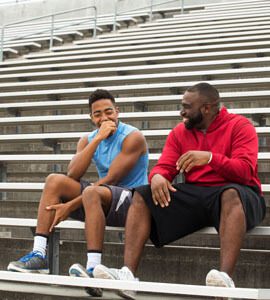Participating in youth sports is great for kids’ health and fitness, but there are some risks, including a higher incidence of stress fractures in young athletes.
A stress fracture is considered an “overuse injury,” and they’re becoming more common in young athletes who are playing competitive sports all year round. Stress fractures are more likely to occur when student-athletes don’t have enough time to rest and let their growing bodies recover from activities properly.
This article covers the different types of stress fractures that student-athletes can experience, what they feel like, and how they’re treated. We’ll also share some tips for preventing injuries, so your young athlete can keep competing in the sports they love.
What Is a Stress Fracture?
A stress fracture (also sometimes called a “hairline fracture”) is a tiny crack that forms in a bone, typically after stress from repetitive movement. Stress fractures in young athletes often occur in the foot or lower leg but can occur in other areas too, like the hip, arm, spine, or ribs.

Researchers found that over half of all stress fractures in student-athletes are experienced by varsity-level teens. The largest group affected were males in track and field. They made up more than a quarter of all stress fractures in the study.
Symptoms
Stress fractures in young athletes can sometimes go unnoticed or ignored until a more serious injury occurs. But in many cases, symptoms are more noticeable or bothersome and can include:
- Swelling (Increases With Activity)
- Pain (Especially When Active)
- Tenderness
What Causes Stress Fractures in Young Athletes?
Most stress fractures in student-athletes occur in a young person’s teen or early college years, but younger children are also at risk as their bones are still growing and developing. Girls are also more likely than boys to develop stress fractures during sports.
Stress fractures can happen during any activity, but they occur most often during high-impact sports, including:
- Running/Track and Field
- Basketball
- Tennis
- Gymnastics
- Dance
Running and jumping contribute to most stress fractures in young athletes. In fact, according to research published by the National Center for Biotechnology Information, track-and-field athletes have the highest incidence of stress fractures compared with other athletes.
The more an athlete experiences the following factors, the higher their risk for a stress fracture:
- Increasing the Activity Frequency, Intensity, or Duration Too Quickly
- Changes to the Usual Surfaces (e.g., Moving From Grass to Turf, etc.)
- Using Improper Equipment or Gear (e.g., Wearing the Wrong Shoes)
- Not Getting Enough Time for Rest Between Activities
Common Stress Fractures in Young Athletes
Stress fractures can impact different parts of the body and have different causes and symptoms. The most common types of stress fractures in student-athletes include:
- Sacral
- Pubic
- Femoral Neck
- Tibial
- Foot and Ankle
Learn the Signs of Youth Athlete Overuse Injuries

Twisting and weight training can sometimes cause stress fractures in teen baseball players.
Sacral Stress Fractures
This type of stress fracture occurs in the lowest part of the spine and can cause lower back and gluteal pain. Sacral stress fractures in young athletes are common in those that participate in long-distance running, like cross country.
Doctors will typically use an MRI to identify sacral stress fractures and locate the site of the injury. With early diagnosis and treatment, outcomes are usually good, and most athletes can return to full participation in their sport within 12 to 14 weeks.
Pubic Stress Fractures
Also referred to as inferior pubic rami stress fractures, this type of injury occurs in the pubic bone and typically causes pain in the hip, buttock, or inguinal area (groin).
Pubic stress fractures in young athletes can cause pain that increases with activity and eases with rest. They can make running, jumping, and even walking difficult.
A bone scan, CT scan, or MRI may be used to diagnose pubic stress fractures. A sports medicine specialist may also want to assess an athlete’s running form and stride to look for any issues that could put them at risk of further injury.
After six to 12 weeks of rest, most athletes can recover from pubic stress fractures and gradually return to their regular activities.
Femoral Neck Fractures
This type of fracture occurs in the upper part of the thighbone (femur), just below the hip joint, and can cause pain in the groin area that gets worse when putting weight on the leg.
A doctor typically diagnoses a femoral neck fracture with an X-ray of the hip, but sometimes they may also order a CT scan or MRI for a more accurate diagnosis.
The severity of femoral neck fractures in young athletes is classified using four stages, with type I being an incomplete, non-displaced fracture (partial break) and Type IV being a complete, fully-displaced fracture (bones are separated and out of alignment).
Conservative treatments like rest and physical therapy can be used to treat many less-severe cases, but for fully-displaced femoral neck fractures, surgery is often the best approach.
Tibial Fractures
Tibial stress fractures in young athletes occur in the lower leg, below the knee. Depending on its location, a tibial fracture can fall into one of three categories:
- Tibial Shaft Fractures: Tibial shaft fractures are the most common type and occur between the knee and ankle joints. They’re typically treated with a leg cast, though some may require surgery to realign the bones.
- Tibial Plateau Fractures: Tibial plateau fractures occur just below the knee joint at the top of the shin bone and involve the knee cartilage. Patients with tibial plateau fractures have a higher chance of developing arthritis in the knee.
- Tibial Plafond Fractures: Tibial plafond fractures occur at the bottom of the shin bone around the ankle joint and involve the ankle cartilage. People with a tibial plafond fracture have a higher chance of developing arthritis in the ankle.
An X-ray, MRI, or CT scan can be used to diagnose tibial stress fractures in young athletes. Many cases can be treated with conservative methods like rest and immobilization with a cast. But in some cases, surgery will be required to ensure the bone heals properly. Surgical treatments can include pins, plates, screws, and rods.
Foot and Ankle Stress Fractures
These types of stress fractures in young athletes occur most often in the metatarsal bones. They’re usually caused by a sudden increase in activities like running or walking. These fractures occur in the heel, fibula (outer bone of the lower leg), talus (lower bone in the ankle joint), sesamoids (small bones of the big toe), and navicular (bone at the top of the foot).
To diagnose foot and ankle stress fractures, a doctor will examine the foot and ankle and check for tenderness. They may also order an X-ray to confirm the diagnosis. It’s essential to see a doctor if you suspect a stress fracture in the foot or ankle, as the bone can break completely without prompt treatment.
Most stress fractures of the foot and ankle can be successfully treated without surgery.
Preventing Stress Fractures in Young Athletes
Oftentimes, overtraining or doing too much too fast can cause preventable injuries in young athletes. Along with support from parents and coaches, athletes can take steps to help prevent stress fractures and other injuries, including:
- Eating a nutritious diet that includes plenty of calcium and vitamin D for strong bones
- Drinking plenty of water during workouts and sports
- Not smoking (smoking can slow the healing of broken bones)
- Starting new activities slowly and gradually increasing activity levels
- Cross-training (alternating between different types of activities)
- Doing proper warm-ups and cool-downs before and after workouts
- Getting a physical from a doctor before participating in sports
- Wearing proper athletic shoes that fit well for each type of activity
- Stopping the activity and seeing a doctor when experiencing pain or discomfort
- Not resuming any activity too quickly after an injury
FAQs About Stress Fractures in Young Athletes
If you have questions about stress fractures in pre-teens and teens, the experts at IBJI have the answers. Here are some answers to queries we often hear from young athletes and their families.
How Will You Know If Your Teen Has a Stress Fracture? How Does a Stress Fracture Feel?
If your teen has a stress fracture, the most common symptoms they will experience can include:
- Pain During Physical Activity (That May or May Not Go Away With Rest)
- Swelling
- Tenderness
- Redness
Are Stress Fractures Common in Student-Athletes?
Stress fractures in young athletes are common, especially during sports that require a lot of running and jumping (e.g., track and field, basketball, etc.) or involve contact with the ground (e.g., dance, gymnastics, etc.).
Can Growth Spurts Cause Stress Fractures?
The bones in the arms, legs, hands, and feet of young people have soft areas of cartilage near the ends of the bones where growth occurs (growth plates). Because these areas are softer than the rest of the bone, they’re more prone to overuse injuries like stress fractures. During children’s growth spurts, the bones are lengthened, and the tissues around them become tight, making kids more prone to fractures.
Can My Child Still Play Sports With a Stress Fracture?
Going back to sports too soon after a stress fracture can worsen the problem and cause further injury. Young athletes may need to rest for as long as 6 to 8 weeks to recover from a stress fracture. A doctor should oversee their recovery and let them know when it’s okay to begin slowly increasing activity. Physical therapy may also be recommended to ensure a safe return to sports.
IBJI Can Help Your Student Athlete Get Back in the Game
Don’t play through the pain. Stress fractures in young athletes should be assessed and treated by a specialist. If you’re experiencing any discomfort, IBJI’s expert team of sports specialists can assess your injury free of charge.
You can also download the IBJI Access app to request a free sports injury screening, schedule an ImPact baseline concussion test, or find the nearest IBJI OrthoAccess® Immediate Care location.
*This content is for information only and is not intended to replace the diagnosis, treatment, or medical advice from your treating healthcare professionals. The content does not provide medical advice, does not constitute the practice of medicine or other healthcare professional services, and does not create a doctor-patient relationship. You should not rely on this information as a substitute, nor does it replace professional medical advice, diagnosis, or treatment. If you have concerns or questions, seek the advice of your healthcare professionals. If you think you may have a medical emergency, call your doctor or 911 immediately. Do not rely on electronic communications or communicate through this website for immediate, urgent medical needs. This website is not designed to facilitate medical emergencies. The use of the information is at the reader’s own risk. The links are provided for information and convenience only. We cannot accept responsibility for the sites linked or the information found here. A link does not imply an endorsement of a site.




